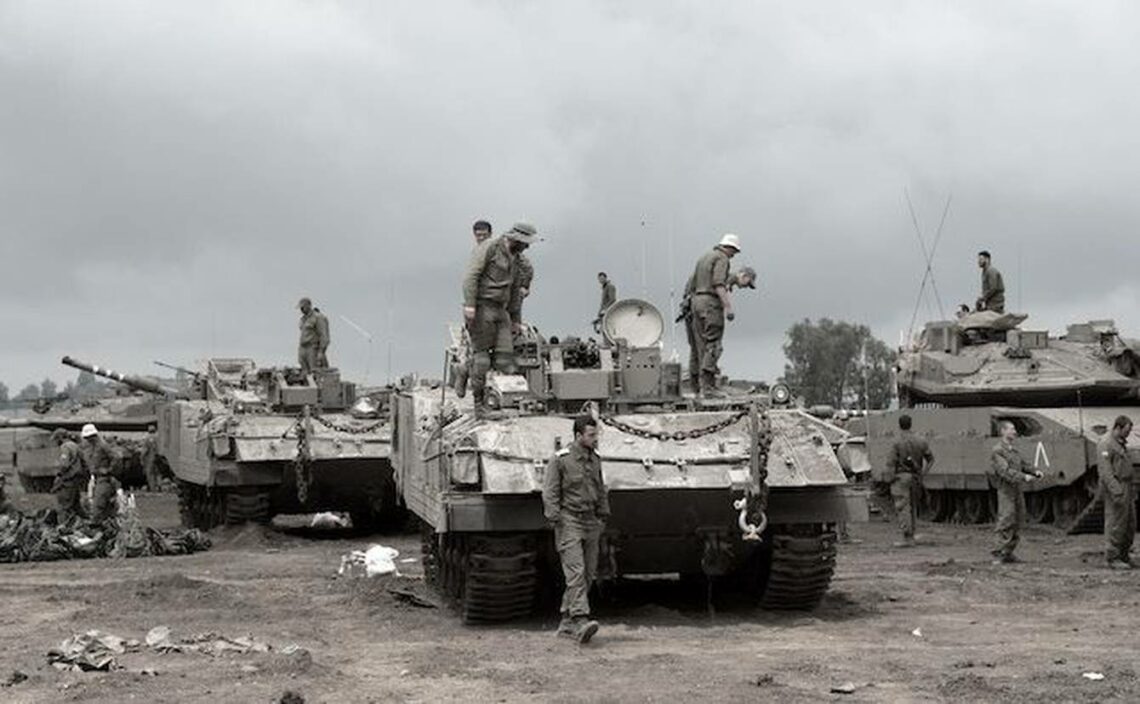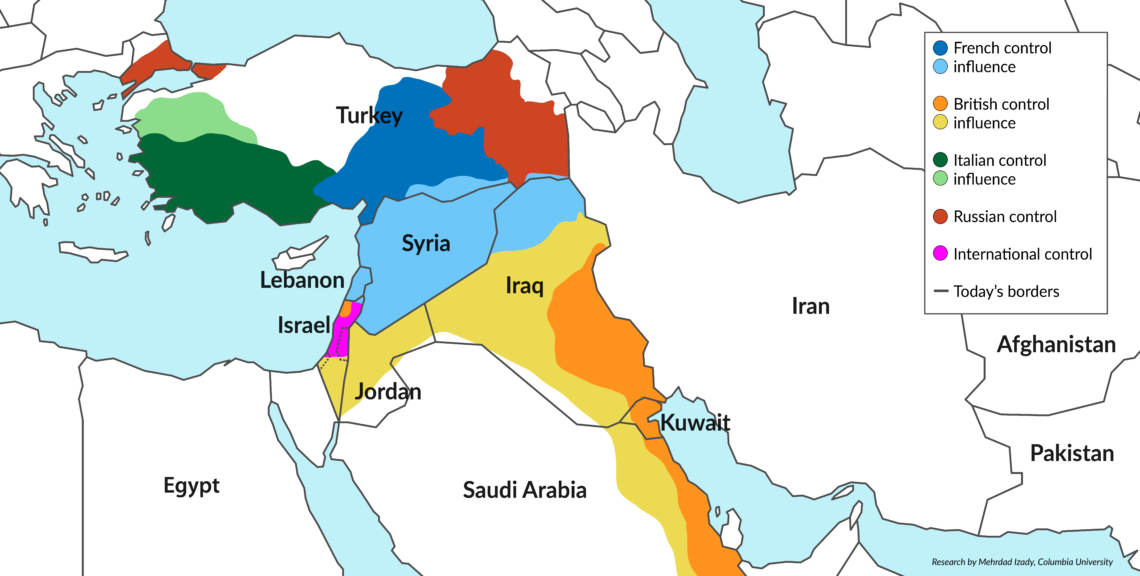A road map for peace in the Middle East
Iran, Saudi Arabia, Turkey, Egypt, and Israel are all vying for supremacy in the Middle East. It may trigger an all-out conflict with dire consequences for the region and Europe. Reversing the logic of war and replacing it with cooperation in the Middle East is difficult but possible, as all the involved parties stand to gain from it.

In a nutshell
- Iran, Saudi Arabia, Turkey, Israel and Egypt are engaged in a zero-sum game for regional hegemony
- Their direct and proxy wars have not produced a winner and threaten to plunge the entire region into a disastrous conflict
- Persuading these powers to switch to cooperation is a tall order, but there’s a road map for how Europe can help
The Middle East is at a crossroads. It could let itself plunge into an all-out war bringing total disaster; Israel and Iran would be the principal actors in this grim script, with the fuse lit in Syria, Lebanon and Gaza. The region could also take a path to peace and reconciliation, allowing a “new Middle East” to emerge. Sketching the political map of a “new Middle East” is akin to envisaging a utopia. However, to avoid the disaster of war there – which would have an incalculable impact on Europe as well, especially in the form of terrorism and refugee flows – it is necessary to draw up a road map that could help bring this utopian vision closer to reality.
The players
The power struggle in the Middle East currently involves Iran, Saudi Arabia, Turkey, Israel and Egypt. These five states are engaged in a zero-sum game. Each is trying to win through a combination of direct confrontation and meddling in the internal affairs of neighbors that are weaker or plagued by domestic crises. Interventions and proxy wars are being played out in Syria and Iraq, Yemen, Qatar, Lebanon, Palestine and Libya. This power struggle has weakened regional players domestically and sometimes prompted shifts toward autocratic governance. None of the contestants has emerged as a winner, while the economic costs have been enormous.
Washington’s approach to the Middle East is driven by diverse American economic interests.
The international powers involved in the Middle East strategy game include the United States, Russia and some European countries. These players have widely divergent interests and modi operandi. Their policies are not only uncoordinated but in many cases conflict.
During the presidency of Barack Obama (2009-2017), the U.S. was keen to withdraw from a region where it had first engaged as a great power after World War II. The current administration’s approach to the Middle East is driven by diverse American economic interests. President Donald Trump has adopted Jerusalem’s position concerning the Palestine question and its assessment of Israel’s security situation. Most notably, the U.S. president shares the view of his Israeli counterpart that Iran is the source of all evil in the Middle East and the ultimate threat to Israel.
Russia, for its part, seeks to regain the foothold in the region it lost after the Soviet Union’s collapse in the early 1990s. Russian President Vladimir Putin is drawing inspiration from the era of Catherine the Great (1762-1796) when Russia was a significant power in the Middle East. Russia’s military involvement in Syria signaled the beginning of a broad regional engagement by Moscow, which strengthened its relations with most powers in the region.
For years, the European Union has remained on the sidelines in Middle Eastern developments. Aside from minor military operations to combat Daesh (a terrorist organization also known as Islamic State or IS, which gained prominence in 2014 when it established a proto-state in parts of Northern Iraq and Syria), EU member states have limited themselves to providing humanitarian assistance to suffering civilians. Such a posture is remarkable given the close political, economic and cultural ties that for centuries existed between Europe and the Middle East. Following World War I, the political remaking of the region by the leading European powers set these newly established states on the paths they have followed ever since. The refugee crisis of 2015-2016 served as a vivid and tragic reminder of the inseparable link between the two regions.
Facts & figures
Sykes-Pikot plan in 1916 and Middle East borders a century later

Facts & figures
Carving up the Middle East in the 20th century
- The secret agreement of May 16, 1916, on dividing up the lands of the then-crumbling Ottoman Empire between French and British spheres of influence, was signed by two mid-level diplomats, Sir Mark Sykes and Francois Georges-Picot
- Other allied countries, Italy and Russia, extended similar secret claims to parts of today’s Turkey; Russia sought to rule the Bosporus Strait and Istanbul
- The existence of these agreements was revealed after revolutionaries opened the archives during the Russian revolution of 1917
- Today’s borders in the Middle East significantly differ from those proposed in the Sykes-Picot plan, reflecting other treaties and the changing interests of Europe’s powers after two world wars
- “Sykes-Picot” became shorthand for the shortsighted postwar land grab that sowed the seeds of today’s internal conflicts and instability in many Middle Eastern countries
Zero-sum to win-win
For decades, political events in the Middle East revolved around the conflict over Palestine. That has been overshadowed recently by the conflict between Iran and Saudi Arabia. A road map for the region’s stabilization must start with efforts to persuade leaders in Tehran and Riyadh that security, stability and economic development will follow from reconciliation and pursuing joint political goals, rather than from conflict. The zero-sum game needs to be turned into a win-win situation. Such an approach would not be radically new.
From the foundation of the Kingdom of Saudi Arabia in 1932, Saudi and Iranian leaders tended to avoid confrontation despite the inherent conflict between Sunni and Shia Islam. It was not until the U.S.-led invasion of Iraq in 2003 and the overthrow of the regime in Baghdad, which served as a buffer between the two local powers, that Iran and Saudi Arabia embarked on a collision course. The conflict became acute as the crisis in Syria escalated from 2012 onwards.
With the Turkish economy having fallen on hard times, Ankara finds its diplomatic isolation even harder to bear.
A comprehensive peace settlement should also be an aim of the other key Middle Eastern capitals – Ankara, Cairo and Jerusalem. Turkey’s intervention in Syria has caused its foreign policy to lose its bearings both in the Middle East and with regard to the rest of the international community. With the Turkish economy having fallen on hard times, Ankara finds its diplomatic isolation even harder to bear.
In Egypt, President Abdel-Fattah El-Sisi’s 2013 coup has returned the country’s military to power. Large sections of the population have high expectations for improvement in the standard of living. To retain his hold on power and shore up Egypt’s position, President Sisi has concentrated his energy on economic development. His ambitious projects can only succeed with the aid of wealthy sponsors in the Middle East and heavy inflows of foreign direct investment. International support is also needed to commercially exploit Egypt’s recently discovered gas reserves. For these and other reasons, stability and peace are in Egypt’s vital national interest.
At first glance, Israel may appear to be coming out on top of the conflicts in the Middle East. Israeli Prime Minister Benjamin Netanyahu’s policy approach exudes confidence. In fact, however, Israel’s security position is fragile for three reasons. First, it is threatened by Islamist radicalization in the neighboring countries. Secondly, it is very difficult to gauge the military capabilities of Israel’s potential opponents, especially of Hezbollah, just across the border in Lebanon. A new, wider war could potentially pose an existential threat to Israel.
Thirdly, Israel runs the risk of international isolation due to its policy of expanding Jewish settlements on the West Bank. President Trump’s close relationship with Mr. Netanyahu should not blind anyone to the tension that has developed between Jerusalem and Washington during the Obama administration. This tension is also reflected in the views of many Americans critical of Israel’s policies. Plenty of detractors can also be found in Europe, including Germany.
Chancellor Angela Merkel’s statement that Israel’s right to exist is a permanent element of German foreign policy, made during Israel’s 60th-anniversary celebrations in March 2008, is today contested by a majority of the German population. Israel’s long-term existence can only be assured through reconciliation with its Arab neighbors.
The road map
Political reconciliation between Iran and Saudi Arabia would go a long way toward stabilizing the region between the Gulf and the Mediterranean, especially the immediate neighborhood of the two states. The Iran-Saudi Arabia tug-of-war is deepening the crises in Yemen and Qatar. Ending these conflicts – in conjunction with the United Arab Emirates – would yield economic gains that could be used to rebuild Yemen and resolve its internal troubles.
Turkey could join that group of powers. When weighing support for the Muslim Brotherhood – an ultimately ephemeral religious and political group – and the conflict with Saudi Arabia and Egypt on the one hand, and on the other closer ties with Saudi Arabia, with the prospect of extending Turkey’s influence throughout the Middle East, the consummate power politician President Recep Tayyip Erdogan might opt for the latter option.
A government in Baghdad recognized as legitimate by the Iraqi people has the potential to resolve the Kurdish issue.
Working jointly with Russia and the EU, the leading powers in the Middle East could form a broad front to develop a viable solution to the Syrian quagmire.
It would also provide the welcome prospect of further stabilization in Iraq. After the U.S. invasion in 2003, Iraq was on the brink of becoming a failed state. One of the critical problems facing the central government in Baghdad after ejecting Daesh from the country’s territory is proxy interventions by Iraq’s neighbors. They have acted by supporting political parties in Iraq, to its great detriment. The parliamentary elections in May 2018 showed that the Iraqi population is losing whatever trust it had in democratic mechanisms.
A government in Baghdad recognized as legitimate by the Iraqi people has the potential to resolve the Kurdish issue in Iraq. Trying to establish an autonomous Kurdish state would not be the right approach, as it would require changes in existing borders, antagonizing all neighbors with large Kurdish minorities. A federal structure would be more practical, as it would enable the Iraqi Kurds to maintain their cultural identity without redrawing the borders. The development of such an arrangement could also serve as a model for dealing with the Kurdish issue in Turkey, Syria and Iran.
Cooperation between the major Islamic powers in the Middle East, with the long-term aim of eliminating regional conflicts and stabilizing the region, would reduce the threat to Israel’s security. The argument that Israel is threatened by its neighbors, especially by Iran, would lose its credibility. As a result, Jerusalem would find itself under pressure to engage in a political process to resolve the Palestinian question.
The EU’s challenge
The transformation of the Middle East outlined above cannot be set in motion without external mediation and support. For the present at least, only the EU can provide this assistance. The European powers played a decisive role in the emergence of the political order in the Middle East after World War I. A century later, the presence of millions of refugees in and outside the region shows the need for a new reordering of the Middle East.
It is incumbent on the EU to take part in that process on new terms – this time based on a partnership, rather than the imperialist dictates of the past. Europe should be aware that its future within the international system of the 21st century depends on its relations with its neighbors.
European diplomats are rightly seeking to maintain constructive relations with Iran.
Can Europe effectively help remold the Middle East? For now, that vision sounds like pie in the sky. However, is not entirely utopian. The wave of protests and uprisings that shook the Arab world in 2011 stemmed from a hunger for dignity and democratic order. Those ideals have been betrayed and thwarted by the rulers, but such yearnings remain common in the Middle East. Ordinary people are seeking a way out through the chaos of the current events. Europe can provide both political and economic assistance.
European diplomats are rightly seeking to maintain constructive relations with Iran in the face of the confrontational U.S. policy. Tehran has understood those signals. The Saudi leadership, mired in a crisis following the widely reported assassination of opposition journalist Jamal Khashoggi, is learning how unreliable President Trump’s rhetoric of support can be. Crisis-stricken Turkey is again seeking closer ties with Europe. And Israel needs to ask itself whether it makes more sense to follow Washington’s whims, or to anchor its future in a broad political and economic partnership between Europe and the Middle East. Following a negotiated solution to the Palestinian issue, this second option would allow Israel to play a strong regional role in a multitude of ways.








